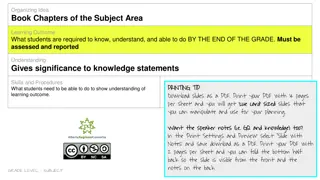Physical Distribution
Physical distribution is a critical aspect of business operations involving the planning, implementation, and control of the flow of goods from origin to consumer. Philip Kotler and William J. Stanton have defined physical distribution as a process of managing the movement of goods to meet consumer
0 views • 8 slides
Exploring the Meaning and Definitions of Physical Education
Physical education involves systematic training and instruction related to physical activities for the development and maintenance of the human body. It encompasses the growth of physical power, the cultivation of physical skills, and overall enhancement of physical well-being. Various definitions h
9 views • 7 slides
Importance of Fitness Testing in Physical Education
Health-related physical activity (HRPA) stresses the need to view fitness testing as a tool to promote increased physical activity levels rather than an end goal. The focus in school physical education is on equipping youth with the knowledge and skills for lifelong health. Fitness test protocols sh
0 views • 17 slides
Understanding Chemical Quantities: The Mole and Molar Mass
Explore the concept of chemical quantities through the mole and molar mass. Learn how to measure substances, calculate moles, find molar masses of compounds, and solve related problems in this informative chapter. Discover the significance of Avogadro's number, representative particles, and more in
7 views • 41 slides
Angular Mechanics - Angular Momentum Concepts and Examples
Understanding angular momentum in mechanics involves reviewing linear and angular quantities, comparing angular to linear formulas, and exploring examples of angular momentum and conservation principles. The content covers key factors like angular quantities, torque, and moment of inertia, along wit
3 views • 23 slides
Understanding Pharmaceutical Degradation: Types and Factors
Pharmaceutical degradation refers to the process of a formulation in a specific container losing its chemical, microbiological, therapeutic, physical, and toxicological specifications. It can be categorized into physical, chemical, and microbiological degradation. Physical degradation alters the dru
1 views • 50 slides
Fundamentals of Mechanics: Introduction to Basic Quantities and Units
Explore the foundational concepts of mechanics in this introductory lecture, covering basic quantities like length, time, mass, and force. Learn about idealizations, units of measurement, SI units, conversion of units, and prefixes used in the context of mechanics.
3 views • 7 slides
Understanding Electrical Quantities and Circuits in Physics
Explore the concepts of electrical quantities such as e.m.f., potential difference, resistance, current, and voltage in circuits. Learn about using voltmeters, measuring resistance, transferring energy in circuits, and understanding the relationships between these electrical properties. Delve into e
2 views • 65 slides
Understanding Physical Quantities and Measurement Systems
Physical quantities can be fundamental or derived, and they play a crucial role in describing physical phenomena. Measurement involves comparing quantities with standard units, with fundamental units for base quantities like length, time, and mass. Different unit systems exist, including CGS, FPS, M
3 views • 13 slides
Understanding Dimensional Analysis in Physics
Dimensional analysis in physics involves defining dimensions of physical quantities, determining dimensionless quantities, checking dimensional consistency of equations, converting units, and exploring the limitations and applications of dimensional analysis. By understanding dimensions and dimensio
0 views • 14 slides
Simple Average Method in Cost Accounting
Simple Average Method, introduced by M. Vijayasekaram, is a technique used for inventory valuation and delivery cost calculation. It involves calculating the average unit cost by multiplying the total unit costs with the number of receiving instances. This method simplifies calculations and reduces
2 views • 5 slides
Understanding Quantity Analysis in Grade Two Mathematics
Students in grade two are expected to analyze quantities up to 1000 by understanding natural numbers, place values, even/odd numbers, composition of groups, and estimation techniques. The curriculum emphasizes representing quantities, decomposing numbers, skip counting, modeling even and odd quantit
0 views • 19 slides
Challenges and Solutions in Cost Control and Monitoring for Construction Projects in Ethiopia
Construction projects in Ethiopia often face cost overruns due to variations, delays, underestimations, and incomplete designs. The methodology for cost control under General conditions of contract includes clauses related to Bill of Quantities, changes in quantities, variations, and payment procedu
0 views • 10 slides
Understanding Ratios with Practical Examples
Ratios describe the relationship between quantities and can be visualized as parts of a whole. Explore equivalent ratios, sharing quantities based on ratios, and solving scenarios involving ratios with examples. Learn how to find missing values in ratios and apply ratio concepts in real-life situati
0 views • 27 slides
IWG Measurement Uncertainties: Justification of Impact Quantities
Explore the justification of main impact quantities in IWG Measurement Uncertainties session held on 6th and 7th October 2020. The analysis includes factors such as deviation from centered driving, start of acceleration, speed variations, load variations, background noise, temperature effects on noi
3 views • 25 slides
Understanding Proportional Relationships in Everyday Scenarios
Exploring proportional relationships through real-life examples such as pricing at a frozen yogurt store, recipe quantities, and earnings calculation to demonstrate the concept and application in various situations. Proportional relationships ensure that quantities change in a consistent ratio, lead
0 views • 5 slides
Understanding Non-Firm Quantities in Electricity Markets
Non-Firm Quantities in electricity markets involve units with non-firm access not being compensated for their non-firm capacity not getting accommodated on the system. The concept of Firm Access Quantity plays a key role in determining compensation levels for units, with differences in implementatio
0 views • 6 slides
Understanding Units and Measurements in Physics
Physics is the study of nature and its phenomena, involving various physical quantities like mass, length, time, area, and volume. These quantities can be fundamental or derived, with units selected as standards for measurement. The System International (SI) units offer advantages like coherence, ra
0 views • 14 slides
Exploring Vectors: Magnitude, Direction, and Operations
Delve into the world of vectors, understanding their properties, how to add and subtract them, and determining their components in different coordinate systems. Learn about scalar quantities, vector quantities, the tip-to-tail rule, and the role of unit vectors in calculations.
0 views • 19 slides
Research Work for Physical Activity Statistics in the Czech Republic
The Czech Republic excels in measures of well-being but faces challenges in income and wealth distribution. Research in physical activity statistics focuses on various aspects like strength, speed, mobility, and mental well-being. Initiatives include assessing energy expenditure from basic activitie
1 views • 23 slides
Understanding Independent and Dependent Quantities in Graphical Representation
Explore the concepts of independent and dependent quantities through examples such as an endangered species project and a commuter flight scenario. Learn how to identify and represent these quantities graphically to deepen understanding. Engage in activities like jigsaw puzzles and matching graphs t
0 views • 11 slides
Fundamentals of Physical Measurements
Science and engineering rely on measurements to understand natural phenomena. Physics aims to predict future outcomes based on observed data and fundamental laws. Base physical quantities like length, time, and mass have standard units, forming the foundation for deriving other physical quantities.
0 views • 13 slides
Understanding Physical Fitness and its Components
Physical fitness encompasses health-related and skill-related components that contribute to overall well-being. Health-related fitness includes muscular strength, endurance, cardiorespiratory endurance, flexibility, and body composition. On the other hand, skill-related fitness comprises speed, agil
0 views • 22 slides
Reimagining Physical Education: A Holistic Approach at St. Peter's Girls Prep School
In the context of St. Peter's Girls Prep School, the philosophy around physical education is explored, emphasizing the integral role it plays in a child's holistic development beyond just playing sports. The approach focuses on instilling healthy habits, balanced nutrition, and physical fitness alon
0 views • 18 slides
Understanding Ratios and Proportions in Mathematics
Ratios are a fundamental concept in mathematics that compare the sizes of different quantities. This content explains how to find ratios between quantities, simplify ratios, and work with ratios expressed in different units or containing decimals. Understanding ratios and proportions is crucial for
0 views • 25 slides
Understanding Ratios, Rates, and Proportions
Explore the concepts of ratios, rates, and proportions through simple examples and explanations. Learn how to express ratios as fractions in their simplest form and understand the relationship between different quantities. Discover how to compare quantities with the same units and represent ratios u
0 views • 24 slides
Understanding Transportation and Assignment Problem
Transportation and assignment problems involve optimizing the shipment of goods from various sources to multiple destinations while minimizing total transportation costs. These problems deal with limited supply, known demand, constant shipping costs, and integer quantities. The transportation algori
0 views • 64 slides
Understanding Quantities of Food: Countable vs. Uncountable Nouns
Exploring countable and uncountable nouns in relation to food quantities. Learn how to differentiate them, use adverbs for specific quantities, and understand the nuances of some, any, few, and fewer in food-related contexts.
0 views • 11 slides
Manufacturing Production Methods Overview
One-off production involves creating unique items with high labor intensity. Batch production allows for the production of specific quantities of similar products using techniques like templates, jigs, and formers. High-volume production focuses on producing large quantities of identical products co
0 views • 5 slides
Understanding Electric Power Systems and A.C. Supply
Exploring the basics of electric power systems, including A.C. and D.C. supplies, circuit parameters, differences between A.C. and D.C. quantities, and the subdivisions of electrical power supply systems such as generation, transmission, and distribution systems. Learn about generating systems, both
0 views • 29 slides
Developing Quantitative Reasoning with "Capturing Quantities" Instructional Routine
Enhance quantitative reasoning skills with the "Capturing Quantities" instructional routine, which focuses on identifying quantities and relationships, creating diagrams, solving word problems, and reflecting on learning through engaging activities and discussions.
0 views • 9 slides
Understanding Radiation Units and Dosimetric Quantities in Radiology
The field of diagnostic radiology relies on various dosimetric quantities and units to measure radiation exposure accurately. From the use of skin erythema dose to principles of ionization chambers, this lecture delves into the importance of understanding and calculating these quantities for effecti
0 views • 25 slides
Grade One Math Learning Outcomes: Quantity Interpretation and Manipulation
Grade One Math curriculum focuses on developing students' ability to interpret and explain quantities up to 100. Students learn to represent quantities using words, numerals, objects, and pictures. They also understand counting principles, such as hierarchical inclusion, and learn to count forwards
0 views • 17 slides
Subitizing to Enhance Number Sense in Elementary Math Education
Explore the importance of subitizing for developing number sense in elementary students. Discover strategies to help students organize quantities efficiently by tens, recognize place value, and engage in skip counting. Use visual aids like ten frames to support conceptual understanding and reinforce
0 views • 54 slides
Factors Influencing Algae Growth in Water Ecosystems
Nutrients play a crucial role in algae growth, with inorganic nutrients like nitrogen and phosphorus being key factors. Algae require macroelements such as carbon, hydrogen, oxygen, sulfur, potassium, calcium, phosphorus, and nitrogen in large quantities, as well as microelements like iron, manganes
0 views • 16 slides
Algebra Application in Pharmacy: Solving Two-Step Equations
Pharmacists indeed use algebra in their profession, involving basic algebra, fractions, percentages, and ratios to ensure accurate dosage calculations for medications. Solving for unknown variables in two-step equations is beneficial for pharmacists, as demonstrated in real-life scenarios like deter
0 views • 39 slides
Solving Math Problems with Patterns and Quantities
Explore mathematical problem-solving strategies with scenarios involving quantities and patterns. From determining the number of flowers based on vases to calculating slices of cheese and tomato needed for sandwiches, these interactive examples enhance your understanding of basic mathematics concept
0 views • 47 slides
Understanding Partial Molar Quantities and Chemical Potential
Exploring partial molar quantities and chemical potential in thermodynamics helps us understand how system variables change with composition alterations. Through concepts like partial molar volumes and Gibbs free energy, we can delve into the intricate dynamics of thermodynamic systems and their beh
0 views • 23 slides
Understanding the Importance of Physical Education and Exercise Science
Explore the contemporary scope of physical education & sport, emphasizing the importance of personal philosophy in this field. Discover goals for physical educators, challenges in promoting physical activity, and the expansion of physical education beyond traditional settings. Understand the impact
0 views • 12 slides
Understanding Skill-Related Fitness: Physical and Emotional Aspects
Skill-related fitness encompasses both physical and emotional components, such as agility, balance, coordination, power, reaction time, and speed. Physical agility involves quick body movements, while emotional agility relates to positive responses in various situations. Physical balance requires we
0 views • 7 slides







































